Astronomy:NGC 6951
| NGC 6951 | |
|---|---|
 NGC 6951 by Hubble Space Telescope | |
| Observation data (J2000 epoch) | |
| Constellation | Cepheus |
| Right ascension | 20h 37m 14.1s[1] |
| Declination | +66° 06′ 20″[1] |
| Redshift | 0.004750 ± 0.000005 [1] |
| Helio radial velocity | 1,424 ± 1 km/s (884.83 ± 0.62 mi/s)[1] |
| Distance | 75.25 ± 11.55 Mly (23.072 ± 3.541 Mpc)[1] |
| Apparent magnitude (V) | 11.0[2] |
| Characteristics | |
| Type | SAB(rs)bc [1] |
| Size | ~100 kly (30.7 kpc) |
| Apparent size (V) | 3′.9 × 3′.2[1] |
| Notable features | Seyfert galaxy |
| Other designations | |
| IRAS 20366+6555, 2MASS J20371406+6606201, NGC 6952, UGC 11604, MCG+11-25-002, PGC 65086[1] | |
NGC 6951 (also catalogued as NGC 6952) is a barred spiral galaxy located in the constellation Cepheus. It is located at a distance of about 75 million light-years from Earth, which, given its apparent dimensions, means that NGC 6951 is about 100,000 light-years across. It was discovered by Jérôme Eugène Coggia in 1877 and independently by Lewis Swift in 1878.[3]
Characteristics

NGC 6951 has a large stellar bar with dust lanes running across it. These lanes come in contact with the circumnuclear ring at its north and south points.[4] Gas is channeled inwards, towards the ring, through the bar. Observations in CO revealed also the presence of molecular gas with inflow motion towards the galactic nucleus. Since there are no signs of interaction with another galaxy in the isolated NGC 6951 for the last one billion years, it is believed that the origin of the gas is internal.[5] Gas kinematics have also been observed for the rest of the galaxy, where the gravitational torques caused by the bar have a dominant role.[6]
Active nucleus
The nucleus of NGC 6951 is active. It has been classified both as a type 2 Seyfert galaxy and a LINER and it has been suggested that it is in transition form, between a Seyfert galaxy and a very-high-excitation LINER, with very strong [N II] and [S II] lines.[7] A supermassive black hole which accretes material in the centre of the galaxy is believed to be the cause of the nuclear activity. The upper mass limit of the supermassive black hole at the centre of NGC 6951 is estimated to be between 6 and 14 million M☉ based on velocity dispersion.[8] Molecular gas, most probably a circumnuclear dust disk or torus less than 50 parsec in radius, has been detected around the nucleus.[9]
Circumnuclear ring
Around the nucleus of NGC 6951 has been observed a star formation ring with a radius of 5 arcseconds.[7] It also emits radio waves.[10] The total gas mass at and inside the ring is estimated to be 3×108 M☉.[11] Inside the ring is detected a spiral-like structure, with two spiral arms, that extends up to 0.5 arcseconds from the nucleus, while no inner bar was detected in the images obtained by Hubble Space Telescope. The central part of the nuclear area contains red supergiant stars.[7] The ring is complete and features H II regions. It is characterised by a gradient in stellar population ages, with the younger stars being a few million years old while the older are more than a hundred million years old.[12]
The stars in the ring form star clusters with masses between 104 and 106.8 M☉. Although there have been observed clusters with ages as little as 4 million years or over one billion years, the star clusters predominantly have intermediate ages, with average ages of 200–300 million years, and are massive. Based on the ages of the clusters it is suggested that the most intense star formation in the ring took place 800 million years ago, then lowered, only to increase again 400 million years ago.[4]
Supernovae
Six supernovae have been observed in NGC 6951: SN 1999el (Type IIn, mag 15.4),[13] SN 2000E (type Ia, mag 14.3),[14] SN 2015G (type Ibn, mag 15.5),[15] AT2016ejj (mag 16.0),[16][17] SN 2020dpw (Type IIP, mag. 17),[18] and SN 2021sjt (Type IIb, mag. 15.9).[19]
See also
- NGC 5135 - a similar active galaxy
References
- ↑ 1.0 1.1 1.2 1.3 1.4 1.5 1.6 1.7 "Results for NGC 6951". NASA/IPAC Extragalactic Database. http://ned.ipac.caltech.edu/cgi-bin/objsearch?search_type=Obj_id&objid=48840&objname=18&img_stamp=YES&hconst=73.0&omegam=0.27&omegav=0.73&corr_z=1.
- ↑ "Revised NGC Data for NGC 6951". http://spider.seds.org/ngc/revngcic.cgi?NGC6951.
- ↑ Seligman, Courtney. "NGC 6951 (= PGC 64650)". http://cseligman.com/text/atlas/ngc69a.htm#6951.
- ↑ 4.0 4.1 van der Laan, T. P. R.; Schinnerer, E.; Emsellem, E.; Hunt, L. K.; McDermid, R. M.; Liu, G. (26 February 2013). "How does star formation proceed in the circumnuclear starburst ring of NGC 6951?". Astronomy & Astrophysics 551: A81. doi:10.1051/0004-6361/201220285. Bibcode: 2013A&A...551A..81V.
- ↑ van der Laan, T. P. R.; Schinnerer, E.; Boone, F.; García-Burillo, S.; Combes, F.; Haan, S.; Leon, S.; Hunt, L. et al. (29 March 2011). "Molecular gas in NUclei of GAlaxies (NUGA)". Astronomy & Astrophysics 529: A45. doi:10.1051/0004-6361/201014488.
- ↑ Haan, Sebastian; Schinnerer, Eva; Emsellem, Eric; García-Burillo, Santiago; Combes, Francoise; Mundell, Carole G.; Rix, Hans-Walter (20 February 2009). "Dynamical Evolution of AGN Host Galaxies - Gas In/out-Flow Rates in 7 NUGA Galaxies". The Astrophysical Journal 692 (2): 1623–1661. doi:10.1088/0004-637X/692/2/1623. https://authors.library.caltech.edu/14260/1/Haan2009p66610.10880004-637X69221623.pdf.
- ↑ 7.0 7.1 7.2 Pérez, E.; Márquez, I.; Marrero, I.; Durret, F.; González Delgado, R. M.; Masegosa, J.; Maza, J.; Moles, M. (1 January 2000). "Circumnuclear structure and kinematics in the active galaxy NGC 6951". Astronomy and Astrophysics 353: 893–909. ISSN 0004-6361. Bibcode: 2000A&A...353..893P.
- ↑ Beifiori, A.; Sarzi, M.; Corsini, E. M.; Bontà, E. Dalla; Pizzella, A.; Coccato, L.; Bertola, F. (10 February 2009). "Upper Limits on the Masses of 105 Supermassive Black Holes from Hubble Space Telescope/Space Telescope Imaging Spectrograph Archival Data". The Astrophysical Journal 692 (1): 856–868. doi:10.1088/0004-637X/692/1/856. Bibcode: 2009ApJ...692..856B.
- ↑ Krips, M.; Neri, R.; García-Burillo, S.; Combes, F.; Schinnerer, E.; Baker, A. J.; Eckart, A.; Boone, F. et al. (11 January 2007). "Molecular gas in NUclei of GAlaxies (NUGA): VI. Detection of a molecular gas disk/torus via HCN in the Seyfert 2 galaxy NGC 6951?". Astronomy & Astrophysics 468 (3): L63–L66. doi:10.1051/0004-6361:20066785. Bibcode: 2007A&A...468L..63K.
- ↑ Saikia, D. J.; Phookun, B.; Pedlar, A.; Kohno, K. (15 February 2002). "Radio observations of the circumnuclear ring in NGC 6951". Astronomy & Astrophysics 383 (1): 98–103. doi:10.1051/0004-6361:20011710. Bibcode: 2002A&A...383...98S.
- ↑ García-Burillo, S.; Combes, F.; Schinnerer, E.; Boone, F.; Hunt, L. K. (23 September 2005). "Molecular gas in NUclei of GAlaxies (NUGA)". Astronomy & Astrophysics 441 (3): 1011–1030. doi:10.1051/0004-6361:20052900.
- ↑ Mazzuca, Lisa M.; Knapen, Johan H.; Veilleux, Sylvain; Regan, Michael W. (February 2008). "A Connection between Star Formation in Nuclear Rings and Their Host Galaxies". The Astrophysical Journal Supplement Series 174 (2): 337–365. doi:10.1086/522338. Bibcode: 2008ApJS..174..337M.
- ↑ Transient Name Server entry for SN 1999el. Retrieved 24 March 2023.
- ↑ Transient Name Server entry for SN 2000E. Retrieved 24 March 2023.
- ↑ List of Supernovae IAU Central Bureau for Astronomical Telegrams. Retrieved 29 December 2015.
- ↑ "Bright Supernova pages - Most prolific galaxies". http://www.rochesterastronomy.org/snimages/sndupe.html.
- ↑ "AT 2016ejj". weizmann.ac.il. https://wis-tns.weizmann.ac.il/object/2016ejj.
- ↑ Transient Name Server entry for SN 2020dpw. Retrieved 24 March 2023.
- ↑ "Latest Supernovae". https://www.rochesterastronomy.org/sn2021/#2021sjt.
External links
- NGC 6951 on WikiSky: DSS2, SDSS, GALEX, IRAS, Hydrogen α, X-Ray, Astrophoto, Sky Map, Articles and images
- NGC 6951 on SIMBAD
 |

